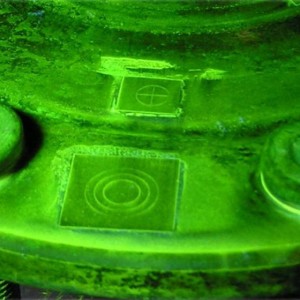Magnetic Particle Inspection Services
 Magnetic Particle Inspection is done by inducing a magnetic field in a ferro-magnetic material and dusting the surface with iron particles (either dry or suspended in a liquid). Surface imperfections will allow the magnetic field to leak out of the part, distort the magnetic field and concentrate the iron particles near imperfections, thus indicating their presence.
Magnetic Particle Inspection is done by inducing a magnetic field in a ferro-magnetic material and dusting the surface with iron particles (either dry or suspended in a liquid). Surface imperfections will allow the magnetic field to leak out of the part, distort the magnetic field and concentrate the iron particles near imperfections, thus indicating their presence.
Magnetic Particle Inspection (or testing) uses magnetic leakage fields to detect surface and subsurface cracks and discontinuities.
Our Magnaflux 6000 amp bench units with 8′ head stocks, portable power packs, yokes, prods, black lights and all required accessories provide the foundation for RNDT to provide quality MT visible and fluorescent, wet and dry examinations in both the lab and field.
Additional Information
Magnetic Particle Inspection (MPI) (or testing) is a nondestructive testing (NDT) process for detecting surface and subsurface discontinuities in ferrous materials. The process puts a magnetic field into the part. The piece can be magnetized by direct or indirect magnetization. Direct magnetization occurs when the electrical current is passed through the test object and a magnetic field is formed in the material. Indirect magnetization occurs when no electrical current is passed through the test object, but a magnetic field is applied from an outside source. The magnetic lines of force are perpendicular to the direction of the electrical current which may be either alternating current (AC) or some form of direct current (DC) (rectified AC).
The presence of a surface or subsurface discontinuity in the material allows the magnetic flux to leak. Ferrous iron particles are applied to the part. The particles may be dry or in a wet suspension. If an area of flux leakage is present the particles will be attracted to this area. The particles will build up at the area of leakage and form what is known as an indication. The indication can then be evaluated to determine what it is, what may have caused it, and what action should be taken if any.
There are several types of electrical currents used in MPI. For a proper current to be selected one needs to consider the part geometry, material, the type of discontinuity you’re looking for, and how far the magnetic field needs to penetrate into the part.
- Alternating current (AC) commonly used to detect surface discontinuities. Using AC to detect subsurface discontinuities is limited due to what is known as the skin effect, where the current runs along the surface of the part. Because the current alternates in polarity at 50 to 60 cycles per second it does not penetrate much past the surface of the test object. This means the magnetic domains will only be aligned equal to the distance AC current penetration into the part. The Frequency of the Alternating Current decides how deep the penetration.
- Direct current (DC, full wave DC) Used to detect sub surface discontinuities where AC can not penetrate deep enough to magnetize the part at the depth needed. The amount of magnetic penetration depends on the amount of current passed through the part. DC is also limited on very large cross sectional parts how effective it will magnetize the part.
- Half wave DC (HWDC, pulsating DC) work similar to full wave DC with sightly more magnetic penetration into the part. HWDC is known to have the most penetrating ability in magnetic particle inspection. HWDC is advantageous for inspection process because it actually helps move the magnetic particles over the test object so that they have the opportunity to come in contact with areas of magnetic flux leakage. The increase in particle mobility is caused by the pulsating current which vibrates the test piece and particles.
Each method of magnetizing has its pros and cons. AC is generally always best for discontinuities open to the surface and some form of DC for subsurface.
- A wet horizontal Magnetic Particle Inspection machine is the most commonly used mass production inspection machine. The machine has a head and tail stock where the part is placed to magnetize it. In between the head and tell stock is a coil, which is used to change the orientation of the magnetic field by 90° from head stock. Most of the equipment is customized and built for a specific application.
- Mobile power packs: Are custom built magnetizing power supplies used in wire wrapping applications.
- Magnetic yoke: is a hand held devices that induces a magnetic field between two poles. Common applications are for outdoor use, remote locations, and weld inspection. The draw back of magnetic yokes are they only induce a magnetic field between the poles so inspection is time consuming are on large parts. For proper inspection the yoke needs to be rotated 90 degrees for every inspection area to detect horizontal and vertical discontinuities. Yokes subsurface detection is limited. These systems used dry magnetic powders, wet powders, or aerosol cans.
References
Wikipedia, Betz, C. E. (1985), ASNT and ISBN 9780318214856
RNDT Inc. provides nondestructive testing, industrial radiography, magnetic particle inspection and more. RNDT, Inc. is an A2LA ISO-17025 accredited commercial testing laboratory headquartered in Johnstown, PA. Our field & laboratory services are offered to all industries. RNDT provides nondestructive testing in the form of industrial x-ray testing (industrial radiography), positive material identification (PMI), liquid penetrant, magnetic particle and ultrasonic testing and visual (CWI) inspections to most all industries. RDNT employs highly trained and experienced nondestructive testing professionals that hold current certifications conforming to the requirements of ASNT SNT-TC-1A & CP-189, National Aerospace Standard NAS-410 Rev. 3, Pressure Equipment Directive 97/23 EC for PED projects. These certifications satisfy global requirements for nondestructive testing personnel.
